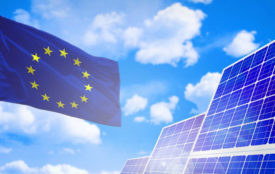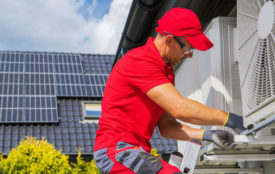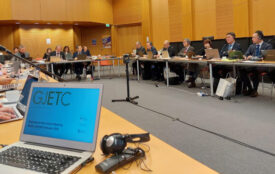UN energy summit: Commitments of more than US$400 billion in new finance and investment announced
New commitments at UN energy summit a major stride towards affordable and clean energy, but much work ahead to halve energy access gap by 2025.
New multi-billion-dollar commitments to increase renewables and access to electricity and clean cooking technologies were announced today at a critical UN energy summit aimed at boosting efforts to reduce the ranks of nearly 800 million people living in energy poverty without electricity access while setting the world on a trajectory towards net-zero-emissions by 2050.
More than US$400 billion in new finance and investment was committed by governments and the private sector during the UN High-level Dialogue on Energy, the first leader-level meeting on energy under the auspices of the UN General Assembly in 40 years.
Over 35 countries — ranging from Small Island Developing States to major emerging and industrialized economies — made significant new energy commitments in the form of Energy Compacts. Additionally, several new partnership initiatives were announced, aiming to provide and improve access to reliable electricity to over a billion people.
The new commitments would result in large increases in the installed capacity of renewable energy and significant improvements in energy efficiency around the world — leading to hundreds of new renewable energy facilities and the creation of millions of new green jobs.
The energy summit took place as world leaders grapple with the critical urgency to keep the 1.5 degrees temperature target of the Paris Agreement within reach, and cut emissions by 45% by 2030, while closing the energy access gap and providing more than one billion people who currently rely on harmful fuels with clean cooking solutions. The new commitments showcase the bold actions needed to meet the targets of Sustainable Development Goal 7 (SDG 7).
A ROADMAP TO 2030
In addition to the announcements of commitments, the Dialogue will also produce a global roadmap for action and timelines needed through 2030 to meet the targets for clean, affordable energy for all set out in Sustainable Development Goal 7, towards net-zero emissions by 2050 in line with the Paris Agreement on Climate Change.
The roadmap, which will be presented in the summary of the Dialogue by the Secretary-General, will call on governments, businesses and civil society organizations to close the energy access gap by 2030, and accelerate the clean energy transition by tripling investments in clean energy and energy efficiency by 2030. It also calls for phasing out coal by 2030 for OECD countries and 2040 for all others, and shifting fossil fuel subsidies to renewable energy investments, while creating new decent and healthy jobs and ensuring a just, inclusive transition. The roadmap draws on inputs from expert working groups and was discussed at Ministerial-level forums in June.
Recent reports from the IPCC and UNFCCC have shown that countries are not moving fast enough on climate action to avert disastrous consequences, and that even if countries met all their NDC commitments under the Paris Agreement, the collective impact would be only a fraction of what is needed to limit warming to 1.5 degrees Celsius.
In addition to mobilizing voluntary commitments, the Energy Compacts can help by encouraging countries to outline the detailed set of energy actions that they have planned to meet their targets and providing an avenue to build partnerships and resources. By engaging business, foundations, civil society organizations and other key players, the Compacts are advancing concrete multi-stakeholder solutions and partnerships needed to achieve greater impact.
FINANCE AND INVESTMENT
More than 150 Energy Compacts from national and local governments, businesses, foundations and international, civil society and youth organizations from every region were submitted for the Dialogue, reflecting actions and finance commitments through 2030.
Clean energy funding committed by national governments and the private sector in these Compacts amounted to more than $400 billion for access and transition. On top of this, several foundations and industry associations aimed to leverage large amounts of additional finance for SDG 7.
On energy access, national governments committed to provide reliable electricity to over 166 million people worldwide; private companies pledged to reach just over 200 million people; and a number of foundations and business associations promised to pursue partnerships to reach hundreds of millions of additional people.
Presently, close to 760 million people still lack access to electricity and some 2.6 billion people lack access to clean cooking solutions. It is estimated that the cost of closing the energy access gap is about $35 billion dollars a year for electricity access and $25 billion dollars a year for clean cooking. The annual investment in clean energy and energy efficiency required to achieve net-zero emissions by 2050 is estimated to be $4.4 trillion.
BOOST RENEWABLES AND ENERGY EFFICIENCY
Commitments under the Energy Compacts could also give a huge boost to renewable energy worldwide. National governments committed to install an additional 698 gigawatts (GW) of clean energy from solar, wind, geothermal, hydro and renewables-based hydrogen, and businesses, notably power utilities, pledged to install an additional 823 GW, all by 2030. Several partnerships and industry associations promised to mobilize an additional 3500 GW of renewables by 2030. One gigawatt is roughly equivalent to the output of 500 onshore wind turbines. The Energy Compacts also include commitments to save energy equivalent to more than 7000 GW by implementing efficiency measures.
The production and use of energy is also the main cause of the climate crisis, accounting for about 75 per cent of total greenhouse gas emissions and making decarbonization of the energy system essential.
A SIGNAL OF WHAT IS POSSIBLE
“The commitments coming through this process led by UN-Energy are a real signal of what is possible,” said UN Secretary-General António Guterres. “I am pleased to see several of the major emitters – countries and sectors – demonstrating leadership through the High-Level Dialogue process along with bold commitments to act.”
“Access to clean, renewable energy is, quite simply, the difference between life and death,” he added. “We must solve these challenges this decade. And we must start today. Without deep and rapid decarbonization of our energy systems over the next 10 years, we will not reach the Paris Agreement goal of limiting temperature rise to 1.5 degrees. This will be fatal to the Sustainable Development Goals.”
“So we have a double imperative,” the Secretary-General said. “To end energy poverty and to limit climate change. And we have an answer that will fulfil both imperatives. Affordable, renewable and sustainable energy for all.”
Mr. Guterres also called for closing the energy access gap by 2030. “That means cutting in half the number of people without access to electricity by reaching 500 million people by 2025. And it means providing over 1 billion people with access to clean cooking solutions by 2025.“
THE WAY FORWARD
In line with the need to continue raising ambition, additional Energy Compacts are expected to be registered in the months ahead, including in the lead-up to the November Climate COP 26, as momentum grows and partnerships are expanded. Progress on the Compacts will be tracked through the 2030 target year, with annual reporting through a publicly transparent online database.
Under the leadership of its Co-Chairs, Achim Steiner, Administrator of UNDP, and Damilola Ogunbiyi, the Special Representative of the UN Secretary-General for Sustainable Energy for All, who have also served as Co-Chairs of the High-level Dialogue, UN-Energy will continue to spearhead transformational commitments and partnerships and sustain the momentum created by the Dialogue, including the Energy Compacts. UN-Energy brings together over 25 UN System entities and key partners for collaboration in the field of energy. Serving as the Secretariat for UN-Energy is UN DESA, under the leadership of Under-Secretary-General Liu Zhenmin, who also served as Dialogue Secretary-General. Given the global challenges at hand, UN-Energy will be further strengthened to help translate the global roadmap into concrete actions.
ENERGY COMPACTS submitted for the High-level Dialogue include the following:
GOVERNMENTS AND PARTNERS
- Denmark committed to reduce national CO2-emissions by 70% in 2030 (compared to 1990), have 100% of electricity from renewable energy by 2028, up-scale offshore wind by potentially up to 12 GW, phase out oil and gas extraction by 2050 and immediately end new licensing rounds; and increase climate finance to at least 500 million USD annually by 2023.
- Germany aims to reach a 30% share of renewable energy in gross final energy consumption by 2030 and increase the proportion of renewable energy in total electricity consumption to 65% by 2030, as well as supporting partner countries in expanding use of decentralized energy and innovative technologies such as green hydrogen and PtX. It will also provide 7 billion euros for speeding up the market rollout of hydrogen technology in Germany and another 2 billion euros for fostering international partnerships.
- India committed to increase renewable energy installed capacity to 450 GW by 2030, develop and implement a National Hydrogen Energy Mission to scale up annual green hydrogen production to ~1 MT by 2030, begin a Production Linked Incentive Scheme to add 10 GW solar PV manufacturing capacity by 2025, create 15 MMT production capacity of compressed biogas (CBG) by 2024, achieve 20% ethanol blending in petrol by Ethanol Supply Year 2025-26 and enhance energy efficiency in agriculture, buildings, industry and transport sectors and promote energy-efficient appliances/equipment to reduce India’s emissions intensity of GDP by 33-35% over 2005 levels by 2030.
- For Latin America and the Caribbean, the RELAC Energy Compact commits that 70% of the installed capacity and electricity generation in the region will be from renewable energies by 2030. Governments participating include: Bolivia, Chile, Colombia, Costa Rica, Dominican Republic, Ecuador, Guatemala, Haiti, Honduras, Paraguay, Peru and Uruguay.
- The Pacific island nation of Nauru pledged to achieve 50% electricity generation from renewable sources by 2023 and a 30% improvement in energy efficiency by 2030, from a 2021 baseline, noting that full implementation of this Compact requires technical and financial support.
- Malawi, conditional on climate finance, targets to achieve universal access to cleaner cooking for households & institutions, phasing out open fires by 2030, with 2 million cleaner cookstoves reached 2021-2025 and an investment of more than $596 million.
- The Netherlands Ministry of Foreign Affairs as well as over 25 Dutch businesses, NGOs and foundations will support access to clean cooking for 45 million people, access to electricity based on renewable energy for 100 million people, and a doubling of job opportunities in the energy transition for women and youth, all by 2030.
- Nigeria committed to electrify 25 million people across 5 million homes by 2023 using solar technologies and creating 250,000 jobs, and also to giving 30 million homes access to clean cooking and energizing agriculture, textile production, cold storage etc. using gas as a transition fuel.
- Sierra Leone’s commitments included: to increase the use of LPG to an adoption rate of 25% as an alternative to wood, ensure that all households have access to energy-saving cooking solutions, and Increase the efficiency of most biomass stoves to a minimum of 20% (Tier 2 stove efficiency).
- The United Arab Emirates commits to provide 100% of the UAE population with access to electricity by 2030 and primary reliance on clean fuels and technologies for cooking by 2030. · UAE also commits to generate 2.5 GW from solar energy in the building sector by 2030.
- The United States commits to creating 35 million new electrical connections for households and businesses by 2030, as well as 80% of the US electricity power generation coming from clean sources. The US Government also put forward commitments to decarbonize the DFC investment portfolio and mobilize USD $25 billion in public sector commitments from Power Africa’s development partners and development institutions.
| PRIVATE SECTOR Enel said it would reach 5.6 million new electricity connections by 2030, speed up its coal phase-out to 2027, triple renewable energy generation to 145GW by 2030 and provide more than 4 million EV charging points and 10,000 electric buses by 2030. The Spanish utility Iberdrola committed to double renewable capacity to 60 GW by 2025 and to provide access to electricity to 16 million people in emerging countries by 2030. The Italian company Graded SpA committed to invest 1.000.000 € in renewable energy, particularly in green-hydrogen development. |
FOUNDATIONS AND COALITION-BASED ENERGY COMPACTS
- The Rockefeller Foundation announced that it was committing $1 billion in philanthropic capital, in partnership with the IKEA Foundation, to scale the distributed renewable energy sector in support of ending energy poverty and combatting the climate crisis. A new platform would aim to empower one billion people with access to reliable, distributed renewably energy and reduce global GHG emissions by up to one billion tons annually.
- The Health Facility Electrification Compact aims to provide 25,000 health facilities with sustainable access to a clean and reliable power source by 2025. Partners include: USAID/Power Africa, Shell Foundation, SEforALL, UNDP, UNICEF, IRENA, Denmark, GAVI, Power for All, Clinton Health Access Initiative, SELCO Foundation.
- The 24/7 Carbon Free Energy (CFE) Compact, led by Google and in partnership with a group of energy buyers and suppliers including governments, aims to transform global electricity grids to “absolute zero” or full decarbonization. Signatories commit to adopting and enabling 24/7 CFE, which means that every kilowatt-hour of electricity consumption is met with carbon-free electricity sources, every hour of every day, everywhere.
- The No New Coal compact includes the Democratic Socialist Republic of Sri Lanka; Republic of Chile; Kingdom of Denmark; French Republic Federal Republic of Germany; United Kingdom of Great Britain and Northern Ireland; and Montenegro committed to a No New Coal Compact, immediately ceasing issuance of new permits for unabated coal-fired power generation projects and cease new construction of unabated coal-fired power generation projects as of the end of 2021.
- The Green Hydrogen Catalogue so far consists of 29 Energy Compacts from governments, intergovernmental organizations, businesses and coalitions, with more expected. Commitments total 268 GW of new renewable energy capacity and 129 GW of new electrolyzer capacity by 2030, and will effect more than 25 million tonnes of green hydrogen.
- An Offshore Wind Energy Compact, submitted by IRENA and the Global Wind Energy Council, committed to achieve 380 GW of offshore wind, including fixed-bottom and floating offshore wind, installed worldwide by 2030, and 2,000GW by 2050.
- A Gender and Energy Compact was initiated by ENERGIA, GWNET and UNIDO, with Ecuador, Iceland, Kenya, Nepal and Sweden (SIDA) as government partners along with some 30 civil society and international organizations. The Compact aims for women to have equal opportunity to lead, participate in and benefit from a just energy transition, and to have equal access to and control over sustainable energy products and services, setting targets to achieve those outcomes.
- Summaries and the complete text of all Energy Compacts registered are available online at https://www.un.org/en/energycompacts/page/registry
- un.org/new-commitments-un-energy-summit
- un-energy.org/high-level-dialogue-energy
- un.org/energycompacts/registry








